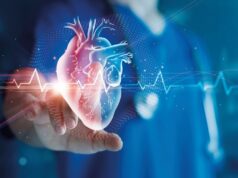Stem cells from the placenta can travel to injured tissues in a mother’s heart during pregnancy and create new cardiac cells, according to a late-breaking basic science abstract presented at the American Heart Association’s Scientific Sessions 2011. The research was also published in Circulation Research, a Journal of the American Heart Association.
Women with pregnancy-associated cardiomyopathy have better rates of recovery than people with any other cause of the disease. So researchers investigated whether fetal cells help repair a woman’s cardiac injury.
In the study, researchers induced heart attacks in pregnant mice and then checked a week or two later to see if the fetal cells had transferred to the mother. To make the fetal cells easy to spot, they were genetically tagged with green fluorescent protein (GFP).
“Much to our surprise, they homed selectively and specifically to just the injured zone of the maternal hearts, not the non-injured zones, and not to non-injured organs within the same mouse,” said Hina Chaudhry, senior author of the study and a cardiologist at Mount Sinai Medical Center in New York, USA.
Two weeks after the animal’s induced heart attack, fetal cells comprised 2% of the maternal heart. Furthermore, the fetus-derived cells differentiated into heart muscle cells and cells that form blood vessels or the inner lining of blood vessels and other organs.
“We found entire blood vessels that were composed of GFP fetal cells in the injury zones,” she said.
The cells could similarly differentiate when isolated from the mother’s heart and grown in petri dishes, even forming beating cardiac cells in culture.
About 40% of the fetal cells that incorporated into the mothers’ hearts expressed a protein called Cdx2, a marker of trophoblast stem cells. Trophoblast stem cells form when embryonic stem cells develop. Though embryonic stem cells lead to all the cell types in the growing baby, trophoblast stem cells give rise to the placenta.
“Trophoblast stem cells have previously not been thought to contribute to organ development other than placenta formation,” said Chaudhry, suggesting placental stem cells may also help others with heart disease. “You could bank placentas and isolate stem cells and potentially use them in other individuals and not just for peripartum cardiomyopathy, but for a broad spectrum of heart diseases,” she said.
Furthermore, using placental stem cells does not violate many religious beliefs like the use of embryonic stem cells.
The researchers are conducting lineage tracing experiments to confirm the precise origin of the cells—of which 60% did not express Cdx2. The non-expressing cells could still be from the placenta and may have switched off Cdx2 or other early progenitor markers and differentiated into cardiac cell types.
Placentas are routinely discarded in labour and delivery rooms. “If we can confirm that trophoblast stem cells are directly involved in mediating cardiac repair in the injury state, then we may just have found that elusive cell type, other than the embryonic stem cell, that can truly become a beating heart muscle cell,” Chaudhry said.
The US National Institutes of Health funded the study.










